Introduction
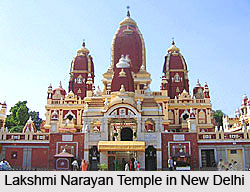 The Lord Vishnu temples with their religiosity and serenity bring out the age-old concept of Vaishnavism.
The Lord Vishnu temples with their religiosity and serenity bring out the age-old concept of Vaishnavism.
Lord Vishnu is the preserver God of the trinity or trimurti, has four hands. Reckoned as the preserver of the universe Vishnu is basically the eternal, unchangeable and immutable illustrating the very traditional concept of Hinduism `Omnipresence of the Omnipotent`.
Lord Vishnu"s preserving and protecting powers have been evidenced to the world in a variety of forms, called Avatars. Numbers of temples are there in India to offer puja to Lord Vishnu in His varied form.
Sculpture of Vishnu Temple
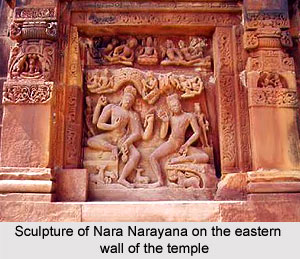 The sculpture of Vishnu temple of Deogarh is a grand example of the Hindu architecture of the Gupta period. It probably dates from the fifth century AD. The carving of the frame complements the richness of the reliefs. The voluptuous grace of the figures and the already recognisable metaphorical conventions of anatomy and features strike a chord to us of the style of Gupta Buddhist sculpture at Sarnath but the elegance and dramatic conception of relief are far more poignant than anything to be found in Buddhist art of the fifth and sixth centuries.
The sculpture of Vishnu temple of Deogarh is a grand example of the Hindu architecture of the Gupta period. It probably dates from the fifth century AD. The carving of the frame complements the richness of the reliefs. The voluptuous grace of the figures and the already recognisable metaphorical conventions of anatomy and features strike a chord to us of the style of Gupta Buddhist sculpture at Sarnath but the elegance and dramatic conception of relief are far more poignant than anything to be found in Buddhist art of the fifth and sixth centuries.
Originally the temple platform was adorned with a continuous fresco illustrating events from the epic Ramayana, which was a popular text during the Gupta times for its heroic description of the conquest of a godly race. The main doorway of the temple at Deogarh serves as an example of the extremely ornate type of portal. The projecting lintel-cornice is a feature that was found in almost all temple entrances. The main motif here consists of luxuriantly ornamented pilasters, alternately square, octagonal, and sixteen-sided in section, supporting an architrave in the shape of an extended vesara or chaitya roof decorated with chaitya dormers. Within this structure there are narrow vertical bands of decoration with depiction of auspicious couples. And in the centre of the over-door slab is a plaque of Lord Vishnu on the great Naga. Around the frame of the doorway are panels with crisply carved foliate details. This is a motif that occurs repeatedly in this arrangement in the buildings of Gupta times. At the bases of the overlapping frames of the door are carvings of female divinities.
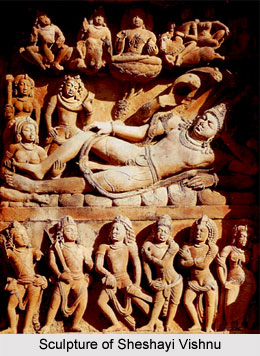 Sculpted panels are seen on the terraced basement, with carved figurines of river goddesses Ganga and Yamuna. They are placed near the next to the doorway to the sanctum sanctorum. On the side walls there are three large carved panels of Vaishnava mythology related to Gajendra Moksha, the Nara Narayana Tapasya (meditation), and the Sheshashayi Vishnu (reclining on the serpent), are illustrated. In the sculpture of Sheshashayi Vishnu, Vishnu is depicted reclining on the serpent Shesha, with four-arms lying down on the spiral of a serpent with seven hoods. It forms a shade over his crowned head. Goddess Lakshmi along with her two attendants, are at the feet of Lord Vishnu. In another panel two demons, Madhu and Kaitabha are about to attack. They are repulsed by the four personified weapons of Vishnu. The lower panel depicts five Pandavas and their wife Draupadi. The relief on the doorway again depicts Vishnu seated on Shesha the serpent, with Lakshmi sitting down and caressing his feet, flanked by two incarnations of Vishnu: Narasimha (the man-lion form) on the right and Vamana avatar (the dwarf form) on the left.
Sculpted panels are seen on the terraced basement, with carved figurines of river goddesses Ganga and Yamuna. They are placed near the next to the doorway to the sanctum sanctorum. On the side walls there are three large carved panels of Vaishnava mythology related to Gajendra Moksha, the Nara Narayana Tapasya (meditation), and the Sheshashayi Vishnu (reclining on the serpent), are illustrated. In the sculpture of Sheshashayi Vishnu, Vishnu is depicted reclining on the serpent Shesha, with four-arms lying down on the spiral of a serpent with seven hoods. It forms a shade over his crowned head. Goddess Lakshmi along with her two attendants, are at the feet of Lord Vishnu. In another panel two demons, Madhu and Kaitabha are about to attack. They are repulsed by the four personified weapons of Vishnu. The lower panel depicts five Pandavas and their wife Draupadi. The relief on the doorway again depicts Vishnu seated on Shesha the serpent, with Lakshmi sitting down and caressing his feet, flanked by two incarnations of Vishnu: Narasimha (the man-lion form) on the right and Vamana avatar (the dwarf form) on the left.
The side and back walls of the temple portray several aspects of Lord Vishnu`s life. On the northern wall "Gajendra Moksha" is depicted that represents Vishnu coming to the rescue of the Gajendra. On the eastern wall, a panel depicts a carved image of the sages Nara-Narayana. On the southern wall, Vishnu is depicted reclining on Shesha the serpent, relaxing or in a sleeping mode.
The entrance represents Vasudeva; the Gajendramoksha side is referred as Samkarshana, the destructive aspect of Vishnu; the Nara-Narayana side is the preserving aspect of Vishnu and the Anantashayana side is called Aniruddha.
Vishnu Temple in Kullu
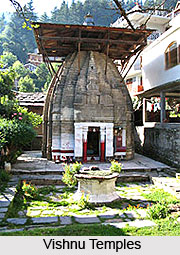 There are two prominent Vishnu Temples in Naggar. One is on the way to the Naggar village on the right side of the road. This Vishnu temple is a humble pyramid-shaped structure and carries substantial archaeological importance. The festival `Ganer` is observed here.
There are two prominent Vishnu Temples in Naggar. One is on the way to the Naggar village on the right side of the road. This Vishnu temple is a humble pyramid-shaped structure and carries substantial archaeological importance. The festival `Ganer` is observed here.
The second Vishnu Temple is located near the castle on the eastern side, a few steps down the main road towards the Naggar village. This also bears semblance to a pyramid with a slatted roof. A notable point to be counted here is that, there is complete absence of a `mandap` in the front portion of the Vishnu Temple. The idol stands on a plinth (kamalasan) and is a chaturbhuj (an idol with four hands) figure. The platform is itself a stone square measuring a foot high. Petals of kamal (lotus) are exquisitely carved around it.
Vishnu Temple in Janjgir
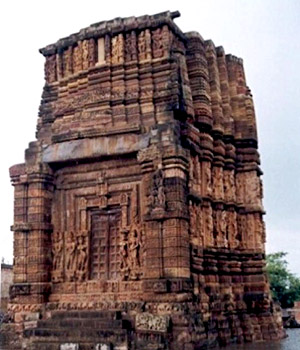 The Vishnu Mandir at Janjgir is an ancient artistic sample of Vaishanv Community. This temple was built by kings of Hayhay Vansh in 12th Century. The plan was to construct the temple in two parts and assemble it but it did not go according to the plans and now we can see these both parts of the temple laying on the ground separately and still the temple is uncomplete. Due to this, the temple is also called as Nakata Mandir by local people. There are some carvings of God and goddess as well as Gandharva and Kinnaras on the walls. This temple sure reflects the artistic richness of the era gone by.
The Vishnu Mandir at Janjgir is an ancient artistic sample of Vaishanv Community. This temple was built by kings of Hayhay Vansh in 12th Century. The plan was to construct the temple in two parts and assemble it but it did not go according to the plans and now we can see these both parts of the temple laying on the ground separately and still the temple is uncomplete. Due to this, the temple is also called as Nakata Mandir by local people. There are some carvings of God and goddess as well as Gandharva and Kinnaras on the walls. This temple sure reflects the artistic richness of the era gone by.
Vishnu Temples of Tirupparkadal
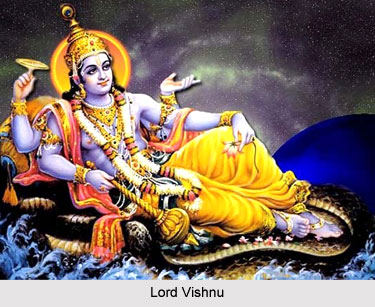 Lord Vishnu is venerated as the supreme god almost in all over South India. Nearly all the villages and towns of South India have the shrines dedicated to lord Vishnu. Approximately thirty kilometers from Kanchipuram is located a small village called Tirupparkadal off the Chennai-Bangalore highway, in Vellore district. This village is fairly close to Tirupputkuzhi which is visited by many ardent Srivaishnavas. This is because this is the abode of Vijayaraghava Svami temple, which is venerated as one of the 108 Divya Desams. In the centre of Tirupparkadal village there are erected two old temples, one dedicated to Lord Prasanna Venkatesa and the other is assigned to Lord Ranganatha. The posture of these two deities is a captivating one. The former is found in a standing posture and the latter in a reclining pose.
Lord Vishnu is venerated as the supreme god almost in all over South India. Nearly all the villages and towns of South India have the shrines dedicated to lord Vishnu. Approximately thirty kilometers from Kanchipuram is located a small village called Tirupparkadal off the Chennai-Bangalore highway, in Vellore district. This village is fairly close to Tirupputkuzhi which is visited by many ardent Srivaishnavas. This is because this is the abode of Vijayaraghava Svami temple, which is venerated as one of the 108 Divya Desams. In the centre of Tirupparkadal village there are erected two old temples, one dedicated to Lord Prasanna Venkatesa and the other is assigned to Lord Ranganatha. The posture of these two deities is a captivating one. The former is found in a standing posture and the latter in a reclining pose.
These Vishnu temples of Tirupparkadal in south India are the legendary ones. The legendary stories associated with these have enhanced the majestic grandeur of the temples. According to the Sthala-Purana of this place, Pundarika Maharishi, who was a great devotee of Lord Narayana came to Tirupparkadal and visited the Ranganatha temple, a significant Vishnu Temple. Just as he was hesitating to enter the other temple adjacent to it, as he did not know if it was dedicated to Vishnu or not, an old man came to him and told him that it was a Vishnu shrine. The sage was usher into the temple by this man and he saw a beautiful image of Vishnu standing on an avudaiyar (the pedestal on which the Siva linga is mounted). Thus lord Vishnu was venerated and worshipped as the presiding deity of these temples.
Vishnu Temple in Bhubaneshwar
Vishnu Temple, depicting the age old concept of Vaishnavism, is located on the eastern back of Bindu Sagar at Talabazar. The temple, dedicated to Lord Vishnu, is positioned on the eastern bank of Bindu Sagar at Talabazar in Bhubaneshwar in Orissa.
Architecture of Vishnu Temple
The 12th century observed the foundation of the Vishnu Temple on the on the right side of the Talabazar road. The temple, dominating the skyline of the town, confirms to the Rekha deula style of architecture, incorporating several unique features.
The temple faces the western direction and is enclosed by Bindusagara tank on the west side, located almost 8 metres across the road. Presently, the sanctum of the temple is used for storage purpose. This religious edifice with its distinctive building style has a sequence of khakhara mundi pilasters engraved on the talajangha. The bandhana however, devoid of any carvings, comprises of three mouldings. A chain of pidhamundi embellishes the upara jangha while five remarkable mouldings define the baranda. The Gandi within the temple has been kept modest excluding the udyota simha in the inner raha and dopichha simha above the kanika paga that exhibit a majestic grandeur.
A profusion of sculptural work can be noticed on the door jambs carved elegantly using three vertical bands of nara sakha, puspa sakha and lata sakha. Two pidha mundi dvarapala niches created at the base of these jambs are occupied with curious male and female figurines of doorkeepers. A divine image of Gajalaxmi is installed at the lalatabimba, depicted as sitting in lalitasana on a lotus pedestal. With her left hand she holds a lotus and her right hand is in varada mudra. Flanked by two full blown lotuses, the goddess blesses her devotees with wealth and prosperity. The eastern wall in the sanctum or garbhagriha that earlier enshrined its presiding deity, is well adorned with two outsized pidha mundi niches. The exterior walls with its distinctive sculptural work and the parsavadevatas in the raha niche certifies about the dedication of the temple to Lord Vishnu.
Devotees visiting the Vishnu Temple can also visit few other temple located in the vicinity. The Ananta Vasudeva Temple located in the northern direction is at a distance of almost 10 metres from the main temple while Ananta Vasudev Bhogamandapa on the eastern side is at a distance of 1 metre from here.
Thrikodithanam Mahavishnu Temple
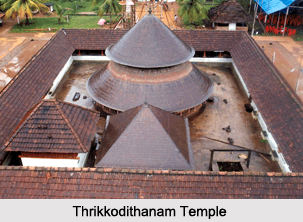 Thrikodithanam Mahavishnu Temple, also known as Adbhuta Narayanan Temple, is a famous temple located at Thrikodithanam in Kerala. It is about 2 km from Changanacherry in Kottayam District. Thrikodithanam Mahavishnu temple is among the five Pandava temples in Kerala that dates back to the 9th century. The Pandavas were the central character in Mahabharata. This ancient temple is dedicated to Lord Vishnu and is considered among the 108 Vishnu temples in India. It is believed that Sahadeva, youngest of Pandavas practised penance here and installed this temple. The presiding deity is Adbhuta Narayanan, made of Aanjana-kallu. The speciality of the temple is Narayanan is presiding here along with his consort Karpagavalli.
Thrikodithanam Mahavishnu Temple, also known as Adbhuta Narayanan Temple, is a famous temple located at Thrikodithanam in Kerala. It is about 2 km from Changanacherry in Kottayam District. Thrikodithanam Mahavishnu temple is among the five Pandava temples in Kerala that dates back to the 9th century. The Pandavas were the central character in Mahabharata. This ancient temple is dedicated to Lord Vishnu and is considered among the 108 Vishnu temples in India. It is believed that Sahadeva, youngest of Pandavas practised penance here and installed this temple. The presiding deity is Adbhuta Narayanan, made of Aanjana-kallu. The speciality of the temple is Narayanan is presiding here along with his consort Karpagavalli.
Architecture of Thrikodithanam Mahavishnu Temple
Thrikodithanam Mahavishnu Temple has been beautifully designed and constructed by the architects. The temple finds its mention in the poems and hymns composed by the greatest of Alwar saints, Nammalvar, in the year 800. The temple is known for its beautiful and attractive mural paintings and stone inscriptions. The circular walls of the temple are adorned with beautiful mural paintings and the scenes from the popular pot dance and umbrella dance. The main attraction of the temple is the 16 panels of beautiful mural paintings in the circular wall around the sanctum.
The temple sanctum is double storied and is known for its architectural beauty. The Aadhisthaana, i.e. the base of the sanctum, is made of three ft high rounded granite stones. About 13 ancient inscriptions can be seen carved on the base stones in the Vaatezutthu Tamil script. Copper tile plates are used to cover the sloping roof. The main entrance of the shrikovil can be reached by climbing four steps of polished black granite. Nalambalam, the space around the sanctum, has a sacred platform called Beli Kallu. Dwaja Sthamba, the ceremonial flag mast ca ne seen here. It is said that in AD 700 the boundary wall of this temple was constructed.
There is a beautiful pound located close to the eastern entrance of the temple. Kazhivetti-kallu, a strange granite statue is positioned between the eastern entrance and the pond. This granite statue is of a man that is six feet in height. He is flat on his back, held up stiff and straight on a stone pillar with only his waist resting on the pillar while rest of the body is unsupported. The main deity of the temple, Adbhuta Narayanan is seen in standing posture. It is made of an unusual black stone called Aanjana-kallu. The temple also houses the idols of Lord Shiva, Lord Krishna, Lord Ganesha, Narasimha, Nagadevas, and Kshetrapala.
Sri Subramanya Temple is the nearby attraction.
Festival of Thrikodithanam Mahavishnu Kshetram
The annual festival of Thrikodithanam Mahavishnu Temple lasts for 10 days. It is celebrated during the lunar month of Vrishchigom i.e. November-December. The major highlight of the festival commences after dusk on the 9th day and carries on until the early hours of 10th day morning. During the festival there is a huge display of 1001 flares made of cloth bundles dipped in oil. These are placed on a pyramidal structure.
Presently Thrikodithanam Mahavishnu Kshetram is administered by the Travancore Devaswom Board (TDB). It is an autonomous body under Government of Kerala.
Srikurmam Vishnu temple
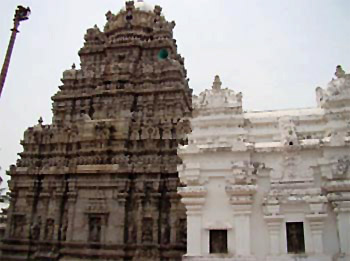 Srikurmam is the only Vishnu temple in Andhra Pradesh where Lord Vishnu is worshipped in the tortoise (kurma) form. Generally, Vishnu`s incarnation as the tortoise (kurma) is not popularly worshipped. It is dedicated to the Lord Vishnu in the Kurma Avathara (incarnation).
Srikurmam is the only Vishnu temple in Andhra Pradesh where Lord Vishnu is worshipped in the tortoise (kurma) form. Generally, Vishnu`s incarnation as the tortoise (kurma) is not popularly worshipped. It is dedicated to the Lord Vishnu in the Kurma Avathara (incarnation).
According to Hindu mythology, Lord Vishnu is one of the most favourite deities of people all over India. Various incarnations of Lord Vishnu such as Varaha, Narasimha, Vamana (Trivikrama), Rama and Krishna are worshipped in Andhra Pradesh. But the one in the form of tortoise is the unique one in the Srikurmam temple of Andhra Pradesh. The tortoise form is generally not popular for worship in any part of India. But in the Srikurmam the tortoise incarnation of Lord Vishnu is worshipped and hence it is unique and rare shrine and several devotees are attracted towards it.
Architecture: The Srikurmam temple of Andhra Pradesh is well known for its beautiful architecture. This temple has 200 pillars and the `gopuram` i, e, the entrance gate has six stories. The gopuram was built by following the traditional South Indian architectural style. The Srikurmam village got its name from the name of this unique temple. In this Vishnu temple, many inscriptions in Devanagari script can be found which can be traced back to the11th to the 19th century A.D. The activities of the kings of the eastern Ganga dynasty can be visualised from these inscriptions. These kings ruled in ancient Kalinga.
Inside the temple complex, many sacred tanks can be found. The famous Sundareshvara temple is also situated near Srikurmam, which is dedicated to Lord Siva and is situated at Pippala village. The Karpureshvara temple is also not far from Srikurmam, which is situated at a place where the Vamshadhara River joins the sea.
A number of inscriptions state this temple is dedicated to Lord Vishnu as the Avathara of Srikurmam - tortoise, and the deity is called Srikurmanatha. The temple has beautiful pillared mantapas and some sculptures are made in granite. The Vimana is built in Chola style. The outer gates beyond the prakara were added much later. The temple was originally Saivite, but was changed to Vaishnavite by Sri Ramanujacharya. This is the only important temple dedicated to Lord Vishnu in the whole of India.
Legend: Naraharitirtha wanted to become a sanyasin and remonstrated with his master that nothing useful was gained by his trying of acquiring a kingdom. His master told him to go to the Gajapathi kingdom to acquire the images of Rama and Sita, so that their worship could be restored. Narahari went to Kalinga and was received with great enthusiasm by the people who made him their ruler. He ruled Kalinga for twelve years as a regent for the minor prince. When the prince attained majority Narahari returned the kingdom to him and took the idols of Rama and Sita as Gurudakshina, and gave them to his master. The latter worshipped the images for 80 days and handed them to his disciple Padmanabhatirtha, who in turn worshipped them for six years and gave them back to Naraharitirtha.
Having acquired the images, Naraharitirtha went around preaching. One night he dreamt that an idol of Lord Vishnu was submerged near a tank in the town. He made arrangements to bring it out and establish proper worship. The inscriptions vouch this story and epigraphs found at the Srikurmam temple also support it. The presiding deity Lord Vishnu is called Srikurmanatha. There are several sacred shrines within the temple. The Lord first appeared here to bless king Swetamahipathi. His bones were thrown into the Swetapushkarani tank and these got converted into tortoises or kurmas, and hence unclean persons are forbidden to touch the water from the tank.
There is a famous Kshetramahatmyam in this temple told by Rishi Dattira. The Sthalapurana states that the sage heard Lord Hari in his dreams giving details about the greatness of Srikurmam. King Suta ruled Swetachala. The queen was a pious lady and once the king approached her on a Suddha Ekadashi day, which she dedicated to prayer and meditation. The queen prayed that her vrata should not be broken, and Lord Srikurmanatha, ordered Ganga to flow between the king and the queen. The king was thus separated from the queen, and he continued living on the banks of the Vamsadhara River. One day Narada met him and told him he could bring blessings upon himself by doing penance. The king went where Vamsadhara River joined the sea, and prayed to the Lord for darshan. On the way he saw a sacred spot and created a tank known as the Ksheera Samudram. Mahalakshmi came and resided here. The spot is called Srikurmam or Kurmagundam.
Vishnu Temple in Baramulla
The prehistoric Vishnu Temple at Buniyar is a perfect example of intricate stonework, epitomizing the craftsmanship of early Kashmiri architecture. Due to age and neglect, the shrine has now reduced to a state of utter dilapidation. Though dedicated to Lord Vishnu originally, any illustration of the commanding deity no longer exists. However, some representation of Lord Shiva can be found in the sanctuary. The Vishnu temple is built on a double platform with porches sided by columns. The roof is understood to have been gabled and two-tired, though nothing remains as testimony for today. A colonnade marks the enclosure complete with pillars and niches. A two-porched gateway still remains on the eastern side.
Vishnu Temple in Chamba
Vishnu Temple is a small place of worship, situated in Saho Village (a charming village located on the right bank of the Sal river) near Chamba district of Himachal Pradesh. The temple enshrines the three-faced idol of Lord Vishnu. The fundamental one is of a human, whereas those on the right and left resemble a lion and a boar respectively. The presiding deity here is established in a standing position with four hands, of which two hands rest on the heads of two cowries-bearers, one holding a lotus and the other one is broken. In the base between His feet lies the bust of a female statuette believed to be that of Goddess Lakshmi. The idols of four-armed Lord Brahma and Lord Shiva are installed on both sides inside the Vishnu Temple. The temple also houses images of the ten incarnations of Vishnu. Vishnu temple is situated opposite to the Chandrashekhar Temple and can be arrived at by bus from the Chamba Bus Depot.
Chengannur Vishnu Temple
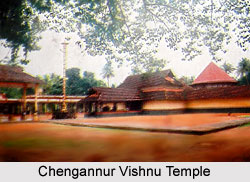 Chengannur Vishnu Temple is one of the five Pandava temples located in the Indian state of Kerala. Tiruchenkunroor is among the five ancient shrines located in the Chengannur area. These temples are all associated with Mahabharata. This temple bears its relation with Yudhisthir. The temple holds great significance in the town and is visited by many devotees from different places. They gather here to offer worship to the deity and receive her blessings.
Chengannur Vishnu Temple is one of the five Pandava temples located in the Indian state of Kerala. Tiruchenkunroor is among the five ancient shrines located in the Chengannur area. These temples are all associated with Mahabharata. This temple bears its relation with Yudhisthir. The temple holds great significance in the town and is visited by many devotees from different places. They gather here to offer worship to the deity and receive her blessings.
Legend of Chengannur Vishnu Temple
Chengannur Vishnu Temple is associated with a legend according to which the eldest of the Pandavas, Yuddhisthira prayed to the Lord Vishnu here. He asked to be pardoned for his act on the battlefield where he uttered the words `Ashwattaama hatah kunjaraha` in an attempt to deceive his teacher Dronacharya and lead him to a defenceless state. In that state Dronacharya was killed by Dhristadyuna, Draupadi`s brother.
Chenkunrur as a town is enclosed with scenic beauty and greenery. The rich lush vegetation of bananas and coconuts adds charm to the place. The temple celebrates its annual festival in the malayalam month of Meenam. It is celebrated on a grand scale where different kinds of dances like Chakkiyar koothy, Koodiyattam are organised.
Anantasaayi Vishnu Temple
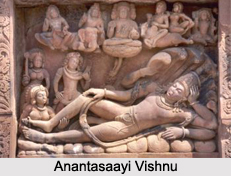 The Anantasaayi Vishnu temple, a Vaishnavite pilgrimage centre, is situated in Sambalpur in the Indian state of Orissa. The temple is well known and visited by thousands of pilgrims magnificent black chlorite idol of the sleeping Vishnu installed in the garbhagriha.
The Anantasaayi Vishnu temple, a Vaishnavite pilgrimage centre, is situated in Sambalpur in the Indian state of Orissa. The temple is well known and visited by thousands of pilgrims magnificent black chlorite idol of the sleeping Vishnu installed in the garbhagriha.
Architecture of Anantasaayi Vishnu Temple
The early sixteenth century stood as the witness to the construction of Anantasaayi Vishnu Temple, a religious edifice reminiscent of the exuberance and proficiency of the ancient period artisans. The temple, confirming to the Rekha deula order, was built by the Chauhan king, Balaram Dev. Images of Lord Ganesha, Garuda and incarnations of Narayana are exhibited within the temple complex. As per a local belief, the image of Narayana was brought by the queen in dowry that was later installed by the king in the temple. Several forms of colourful festivals celebrated in honour of Lord Vishnu are organised by the temple authorities with special consideration given to Ananta Chaturdashi that falls during Bhadrapada.
Anantasaayi Vishnu Temple is well connected by different modes of transport. Tourists visiting the temple can avail the buses plying from different cities. The nearest railway station is located at Sambalpur in Kamali Bazar near Bada Bazar at a distance of two kilometres from the temple.
Vishnu Temples of Uttiramerur
In the small village of Uttiramerur in south India is stationed some small shrines dedicated to lord Vishnu. The historic village of Uttaramerur (Uttiramerur), is situated approximately twenty-five kilometers south-west of Kanchipuram. It has been discovered by the historical researches that the village of Uttiramerur was in existence from the Pallava period of the 8th century A.D. or perhaps even earlier. In present times the small village of Uttiramerur came in limelight owing to the existence of two ancient Vishnu temples dedicated to Sundaravarada Perumal and Vaikuntha Perumal, situated in the hub of this place. The numerous inscriptions found here reveal that once this village was populated by scholars well-versed in Vedic lore, this place was also venerated as chaturvedimangalam. In various periods of time it was called by different names like Uttaramerur-chaturvedimangalam, Rajendra Chola chaturvedimangalam, Vijayagandagopala-chaturvedimangalam and Vadameru-mangai, thus providing an idea of how popular it once was and the prestige it enjoyed among royalty and lay people alike. The Vishnu temples at the heart of this small village have enhanced the antique grandeur of the temple.
Sri Sundaravarada Perumal temple, Uttiramerur, South India : The Vishnu temple is one of the significant Vishnu temples studded with stone images and enshrines nine different enchanting postures of the Lord. The temple is a legendary one depicting the
Vaikuntha Perumal temple is another Vishnu temple of worth importance stationed in the small village of Uttiramerur. Situated very near the Sundaravarada Perumal temple is located another ancient Vishnu shrine dedicated to Vaikuntha Perumal
Srikurmam Vishnu Temple
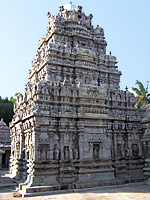 Location: Srikakulam
Location: Srikakulam
Deity: Vishnu - Srikurmanatha. This a famous temple situated about twelve miles east of Srikakulam.
Architecture: A number of inscriptions state this temple is dedicated to Lord Vishnu as the Avathara of Srikurmam - tortoise, and the deity is called Srikurmanatha. The temple has beautiful pillared mantapas and some sculptures are made in granite. The Vimana is built in Chola style. The outer gates beyond the prakara were added much later. The temple was originally Saivite, but was changed to Vaishnavite by Sri Ramanujacharya. This is the only important temple dedicated to Lord Vishnu in the whole of India.
Legend: Naraharitirtha wanted to become a sanyasin and remonstrated with his master that nothing useful was gained by his trying to acquire a kingdom. His master told him to go to the Gajapathi kingdom to acquire the images of Rama and Sita, so that their worship could be restored. Narahari went to Kalinga and was received with great enthusiasm by the people who made him their ruler. He ruled Kalinga for twelve years as a regent for the minor prince. When the prince attained majority Narahari returned the kingdom to him and took the idols of Rama and Sita as Gurudakshina, and gave them to his master. The latter worshipped the images for 80 days and handed them to his disciple Padmanabhatirtha, who in turn worshipped them for six years and gave them back to Naraharitirtha.
Having acquired the images, Naraharitirtha went around preaching. One night he dreamt that an idol of Lord Vishnu was submerged near a tank in the town. He made arrangements to bring it out and establish proper worship. This story is vouched by the inscriptions and epigraphs found at the Srikurmam temple. The presiding deity Lord Vishnu is called Srikurmanatha. There are several sacred shrines within the temple. The Lord first appeared here to bless king Swetamahipathi. His bones were thrown into the Swetapushkarani tank and these got converted into tortoises or kurmas, and hence unclean persons are forbidden to touch the water from the tank.
There is a famous Kshetramahatmyam in this temple told by Rishi Dattira. The Sthalapurana states that the sage heard Lord Hari in his dreams giving details about the greatness of Srikurmam. King Suta ruled Swetachala. The queen was a pious lady and once the king approached her on a Suddha Ekadashi day, which she dedicated to prayer and meditation. The queen prayed that her vrata should not be broken, and Lord Srikurmanatha, ordered Ganga to flow between the king and the queen. The king was thus separated from the queen, and he continued living on the banks of the Vamsadhara River. One day Narada met him and told him he could bring blessings upon himself by doing penance. The king went where Vamsadhara River joined the sea, and prayed to the Lord for darshan. On the way he saw a sacred spot and created a tank known as the Ksheera Samudram. Mahalakshmi came and resided here. The spot is called Srikurmam or Kurmagundam.





















